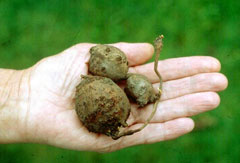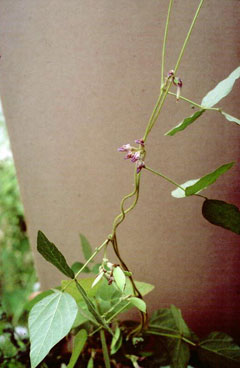 |
|
(c) 2010 Ken Fern & Plants For A Future |
 |
|
Translate this page:
Summary
Groundnut - Apios americana is a herbaceous perennial climber with edible tubers, seeds and leaves. It scrambles over shrubs or will twine around supports.
Physical Characteristics

 Apios americana is a PERENNIAL growing to 1.2 m (4ft).
Apios americana is a PERENNIAL growing to 1.2 m (4ft).
See above for USDA hardiness. It is hardy to UK zone 3. It is in leaf from April to November, in flower from June to September. The species is hermaphrodite (has both male and female organs) and is pollinated by Insects.
It can fix Nitrogen.
Suitable for: light (sandy) and medium (loamy) soils and prefers well-drained soil. Suitable pH: mildly acid, neutral and basic (mildly alkaline) soils and can grow in very acid soils.
It can grow in semi-shade (light woodland) or no shade. It prefers moist soil.
UK Hardiness Map
US Hardiness Map
Synonyms
A. tuberosa. Glycine tuberosa.
Plant Habitats
Woodland Garden Sunny Edge; Cultivated Beds;
Edible Uses
Edible Parts: Root Seed Seedpod
Edible Uses:
Tuber - raw or cooked[1 , 2 , 27 , 55 , 62 , 63 ]. A delicious flavour somewhat like roasted sweet potatoes, it always receives very high marks in taste trials with us[K ]. The tuber can also be dried and ground into a powder then used as a thickening in soups etc or can be added to cereal flours when making bread[132 , 257 ]. Tubers contain 17% crude protein, this is more than 3 times that found in potatoes[183 ]. The tubers can be harvested in their first year but they take 2 - 3 years to become a sizeable crop[160 ]. They can be harvested at any time of the year but are at their best in the autumn[160 ]. The tubers can also be harvested in the autumn and will store until at least the spring[K ]. Yields of 2.3 kilos of tubers per plant have been achieved[222 ]. Seed - cooked[62 ]. Rather small and not produced very freely[K ], they are used like peas and beans[183 , 213 ]. A good source of protein, they can be ground into a powder and added to cereals when making bread etc[257 ]. The seedpods are 5 - 13cm long, containing 6 - 13 small seeds[418 ]. Young seedpods[55 , 62 , 95 , 177 ]. The seedpods are up to 13cm long[418 ].
References More on Edible Uses
| Composition
|
| Figures in grams (g) or miligrams (mg) per 100g of food.
|
|
|
Root (Fresh weight)
|
|
- 0 Calories per 100g
- Water : 0%
- Protein: 17g; Fat: 0g; Carbohydrate: 0g; Fibre: 0g; Ash: 0g;
- Minerals - Calcium: 0mg; Phosphorus: 0mg; Iron: 0mg; Magnesium: 0mg; Sodium: 0mg; Potassium: 0mg; Zinc: 0mg;
- Vitamins - A: 0mg; Thiamine (B1): 0mg; Riboflavin (B2): 0mg; Niacin: 0mg; B6: 0mg; C: 0mg;
- Reference: [ ]
- Notes:
|
|
Medicinal Uses
Plants For A Future can not take any responsibility for any adverse effects from the use of plants. Always seek advice from a professional before using a plant medicinally.
The tubers were used in folk remedies for that cancerous condition known as "Proud Flesh" in New England. Nuts were boiled and made into a plaster, "For to eat out the proud flesh they (the Indians) take a kind of earth nut boyled and stamped"[269].
References More on Medicinal Uses
The Bookshop: Edible Plant Books
Our Latest books on Perennial Plants For Food Forests and Permaculture Gardens in paperback or digital formats.

Edible Tropical Plants
Food Forest Plants for Hotter Conditions: 250+ Plants For Tropical Food Forests & Permaculture Gardens.
More

Edible Temperate Plants
Plants for Your Food Forest: 500 Plants for Temperate Food Forests & Permaculture Gardens.
More

More Books
PFAF have eight books available in paperback and digital formats. Browse the shop for more information.
Shop Now
Other Uses
References More on Other Uses
Cultivation details
Agroforestry Services: Nitrogen Edible Beans Management: Standard New Crop for Tubers Staple Crop: Protein
Apios american tolerates a range of climatic conditions, producing well in cool temperate zones as well as the subtropical conditions of South Florida[269 ]. Prefers a light, rich soil and a sunny position[1, 27 ]. When grown in a warm dry situation in well-drained sandy soil, the plants will be long-lived with the tuberous roots increasing in size and number each year[245 ]. Another report says that the plant prefers light dappled shade[200 ]. It tolerates acid soils[160 ]. Prefers a pH in the range of 5 - 7.5, tolerating 4.5 - 8.5[418 ]. Dislikes windy situations[K ]. Apios americana is a plant of the temperate zone, where it is found at elevations up to 1,000 metres. It grows best in areas where annual daytime temperatures are within the range of 10 - 20°c but can tolerate 8 - 30°c[418 ]. When dormant, the plant can survive temperatures down to about -40°c, though young growth can be damaged by frosts[418 ]. It prefers a mean annual rainfall in the range 1,000 - 1,200mm, but tolerates 700 - 1,500mm[418 ].The groundnut has occasionally been cultivated for its edible root and has the potential to become a commercial crop[95, 183 ]. Cultivars have been selected in the past for higher yields and larger tubers, it is said that the yields from some of these cultivars can rival potato crops[95, 183 ]. Some of these cultivars are gradually becoming available in Britain[K ]. The best yields are obtained when the plant is left in the ground for at least two growing seasons. Yields of 30 tonnes per hectare have been achieved from weed crops growing in a field of cranberries[269 ]. This species has been grown in the past in S. Europe[46, 50 ] and has been suggested as a nitrogen-fixing edible ornamental for permaculturalists[222 ]. The plant forms long thin roots which enlarge at intervals along their length to form the tubers; the effect is somewhat like a necklace[K ]. The flowers have the scent of violets[245 ]. This species has a symbiotic relationship with certain soil bacteria; these bacteria form nodules on the roots and fix atmospheric nitrogen. Some of this nitrogen is utilized by the growing plant, but some can also be used by other plants growing nearby[200 ]. ]. No pruning needed, it will die down in the fall.
Carbon Farming
-
Agroforestry Services: Nitrogen
Plants that contribute to nitrogen fixation include the legume family – Fabaceae.
-
Edible Beans
Grown for Edible Beans.
-
Management: Standard
Plants grow to their standard height. Harvest fruit, seeds, or other products. Non-Destructive management systems.
-
New Crop for Tubers
Most new crops were important wild plants until recently, although some are the result of hybridization. They have been developed in the last few, decades. What they have in common is that they are currently cultivated by farmers.
-
Staple Crop: Protein
(16+ percent protein, 0-15 percent oil). Annuals include beans, chickpeas, lentils, cowpeas, and pigeon peas. Perennials include perennial beans, nuts, leaf protein concentrates, and edible milks.
References Carbon Farming Information and Carbon Sequestration Information
Temperature Converter
Type a value in the Celsius field to convert the value to Fahrenheit:
Fahrenheit:
The PFAF Bookshop
Plants For A Future have a number of books available in paperback and digital form. Book titles include Edible Plants, Edible Perennials, Edible Trees,Edible Shrubs, Woodland Gardening, and Temperate Food Forest Plants. Our new book is Food Forest Plants For Hotter Conditions (Tropical and Sub-Tropical).
Shop Now
Plant Propagation
Seed - pre-soak for 3 hours in tepid water and sow February/March in a cold frame. The seed usually germinates in 1 - 3 months at 15°c[134]. When large enough to handle, prick the seedlings out into individual pots and grow them on in light shade in the greenhouse for their first winter, planting them out in late spring or early summer. Division can be carried out at almost any time of the year, though spring is probably the best time. Simply dig up the roots, harvest the tubers and replant them where you want the plants to grow. It is also possible to harvest the tuber in winter, store them in a cool fairly dry but frost-free place over the winter and then plant them out in the spring. The tubers lose moisture rapidly once they have been harvested, so make sure that you store them in a damp medium such as leafmold.
Other Names
If available other names are mentioned here
Wild Potato, Potato bean, Hopniss, American groundnut, Indian potato
Native Range
NORTHERN AMERICA: Canada, Québec (south), Nova Scotia, Ontario (south), New Brunswick, United States, Connecticut, Indiana, Maine, Massachusetts, Michigan, New Hampshire, New Jersey, New York, Ohio, Pennsylvania, Rhode Island, Vermont, West Virginia, Illinois, Iowa, Kansas (northeast), Minnesota, Missouri, Nebraska, Oklahoma (east), South Dakota (east), Wisconsin, Colorado (north-central), Alabama, Arkansas, Delaware, Florida, Georgia, Kentucky, Louisiana, Maryland, Mississippi, North Carolina, South Carolina, Tennessee, Virginia, District of Columbia, Texas,
Weed Potential
Right plant wrong place. We are currently updating this section.
Please note that a plant may be invasive in one area but may not in your area so it's worth checking.
Conservation Status
IUCN Red List of Threatened Plants Status :

Growth: S = slow M = medium F = fast. Soil: L = light (sandy) M = medium H = heavy (clay). pH: A = acid N = neutral B = basic (alkaline). Shade: F = full shade S = semi-shade N = no shade. Moisture: D = dry M = Moist We = wet Wa = water.
Now available:
Food Forest Plants for Mediterranean Conditions
350+ Perennial Plants For Mediterranean and Drier Food Forests and Permaculture Gardens.
[Paperback and eBook]
This is the third in Plants For A Future's series of plant guides for food forests tailored to
specific climate zones. Following volumes on temperate and tropical ecosystems, this book focuses
on species suited to Mediterranean conditions—regions with hot, dry summers and cool, wet winters,
often facing the added challenge of climate change.
Read More
Expert comment
Author
Medik.
Botanical References
43200
Links / References
For a list of references used on this page please go here
Readers comment